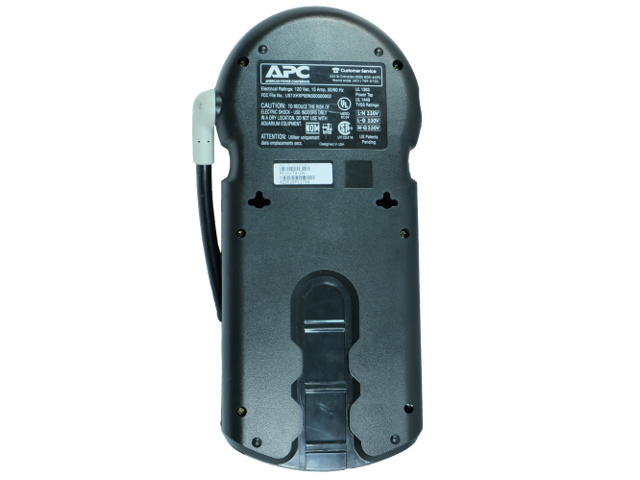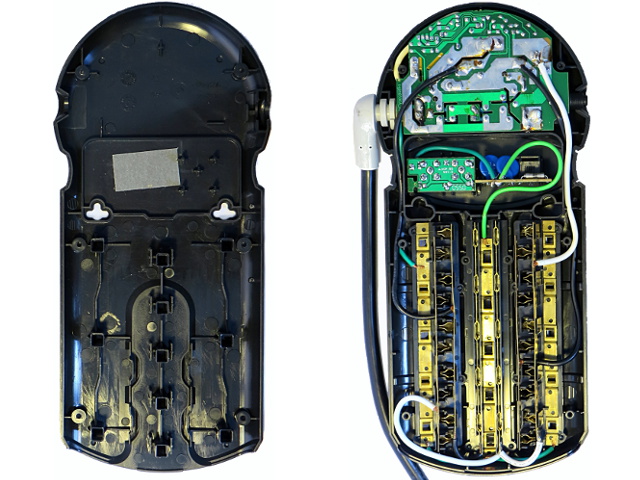Let's Take a Trip Inside a Power Strip!
We count on power bars to protect our expensive PC hardware, and it's easy to take them for granted. Recently, one of our writers took an APC unit apart, though, and discovered some disturbing manufacturing work. Follow along as we dig into his findings.
The PC's Underappreciated Protector
We often mention power supplies when we talk about the unsung heroes of enthusiast computing. But what about the humble power bar? Aside from the obvious task of providing multiple outlets for all of the gadgets you have around your computer, they also provide a central, common ground location for all of that equipment, minimizing ground loops. Most bars also give you some degree of surge suppression and power filtering.
In this picture story, we're taking a look at what goes on inside of a vintage APC Performance SurgeArrest (specifically, model PF11VT3-CN).
An Old-ish Classic
Here, in all of its curvy glory, is APC's Performance SurgeArrest with 11 outlets. Six are power brick pads, three are always-on, and the rest are controlled by the built-in switch. You get a two-meter power cable, phone line and coax cable surge protection, a 15 A breaker (on the left side), status indicator LEDs, a removable cable management clip, and 3200 Joules of surge suppression with $100,000 equipment protection warranty.
Given such a show of confidence from one of the top-rated brands in power products, you'd expect fairly good quality from this power bar, which used to sell for about $40. APC's nearest equivalent model today is the P11GTV, which has a similar outlet configuration, redesigned top-end layout, and a more blocky design overall. It retails for around $60.
Flipping APC's Bar Over
The back of the unit features two mounting slots (which can accommodate three orientations), six screws holding the unit together, the wire management clip's attachment slot, and, of course, the electrical ratings and certifications sticker. We'll take a closer look at that next.
Everyone Loves Stickers
This unit was designed in the United States, but was assembled in the Philippines. It has all of the usual safety certifications, an FCC file number, and transient voltage suppression ratings of 330 V across all three power cable wire pairs.
Oddly, the French warning on the label allows for the use this power bar for anything, anywhere, as long as it stays dry, while the English warning only permits use indoors and makes an exception for aquariums.
Get Tom's Hardware's best news and in-depth reviews, straight to your inbox.
Clippy? Is That You?
Back when I originally purchased these bars (I own three), I thought the cable management clip was neat. Over time, I gave up on using it; invariably, the device I wanted to move ended up being the one with its cord nestled deepest into the clip. The plastic's somewhat sharp edges also contributed to my decision to quit using it.
Perhaps unsurprisingly, APC's updated SurgeArrest line-up dropped this feature in favor of cable straps.
Open Sesame
Six screws later, the back cover comes off effortlessly, which is considerably more pleasant to deal with than the mess of ultrasound-, solvent- or induction-welded enclosures.
At a glance, everything looks nice, clean, and modular: there are shiny sheet-metal bus bars for power and ground distribution to outlets; separate modules for coax and phone surge suppression; and a larger board for the bar's core business—power filtering and surge suppression.
The only questionable design choice apparent in this picture is the daisy-chained grounds for the phone and coax modules. For surge suppression to be most effective, the lowest impedance possible between the surge suppression devices and ground is required. Ideally, APC should have connected all of its grounds to a central point within the bar, preferably where the main cable's ground connects to the PCB.
Triple Play
APC uses three different styles of connection strips:
- simple slit squares for all three ground bus bars
- offset stamped metal for the five center outlets' live and neutral connections
- more elaborate arced fingers for the power brick outlets
I see at least two problems here:
- The copper alloy that APC employs is very plastic. If anything happens to bend those contacts a little more than normal, they become loose. This is most evident in the ground strips, and I had never noticed how loose some of them had become until I tried plugging my lamps into another SurgeArrest bar for this photo shoot, only to discover that the center outlets were unusable with the thin plug blades.
- More daisy-chained grounds. APC could have at least connected the phone/cable surge suppression ground to the top strip, to which the ground connection from the main PCB connects.
Out Of Shape?
Let's take a closer look at those connection strips.
Since APC uses exactly the same ground strips for the power bricks and the middle row—with the brick strips only having every other position available—we can clearly see the difference between virgin ground connection slots and those that have seen some traffic. The wear on the other types of contacts is not readily observable, but the metal color does suggest that the strips are made of the same malleable copper alloy. APC probably should have used a more springy or elastic alloy in these things.
With some of those ground slots bent beyond perpendicular, you can start wondering how well the ground contact with plugs might actually be after a few insert-remove cycles.
The rough child-proofing mechanism in front of the live and neutral connections does not help with smooth insertion. That likely contributed to the ground connections taking a worse beating than they should have.
Instead of soldering, screwing, or crimping the wires to the bars, APC opted for spot-welding, providing a quick (yet durable) connection.
Partial Cover
Here is that little RF surge-suppression module, with all of its goodies hidden under a metal skirt.
Looking at the back of this PCB, it is obvious that there's little going on. Pins related to the F-connectors aside, there are at most two other components under there. One might be a gas discharge tube connected across the signal path and ground between the two F-connectors, and another, possibly a jumper, connected to the same trace at both ends.
APC cut corners by leaving the RF trace exposed on the back instead of using a double-sided board, so it could have put this on the top layer (facing inside the shield) with a solid ground layer on the bottom to complete the shielding.
Can You Hear Me Now?
Next comes the phone surge-suppression module. It's nothing fancy: a simple pair of fuses and two S14K175 MOVs.
One of those ground wires has a couple of strands splayed around the wire's entry point through the PCB, and the other has a lump of solder, presumably stuck to more stray strands. Was this unit assembled on a Monday morning or Friday afternoon?
The Nitty Gritty
On the rounded PCB edge, we see the wiring fault red LED, the overload yellow light with the neutral wire passing through a current-sensing transformer, and the Protection Working green LED.
Closer to the middle, there is a pair of beefy ferrite bar chokes and a 0.47 uF MPX-X2 providing some line noise filtering, along with the built-in switch for the eight corresponding outlets.
Along the right and bottom, we find nine MOVs providing surge protection. A 15 A built-in breaker and two thermal fuses are amongst them. The protection uses 20D201K parts (200 V) across live- and neutral-ground connections, while the other MOVs are 20D471K components (470 V) that go directly across live and neutral.
A 221R UMI thermal fuse (the thin, long, yellow device sandwiched between the four 20D201K on the right edge) rated for 102 C and 4 A breaks the ground connection should the surrounding MOVs start overheating. There is another thermal fuse heat-shrunk between the two MOVs above the breaker that is in series with the live connection directly from the power cord. It cuts off all power to the bar should those MOVs overheat.
At a glance, everything looks nice. Upon closer inspection, though...
-
nukemaster Very surprised to see the inside of that(and I have 2 APC UPSs sitting in front of me.).Reply
Also never though of using the de-soldering braid as a patch :) -
Onus It seems to me that it might be worthwhile taking a look at the innards of some more of these. This doesn't give me any warm fuzzies about APC. What happened to pride in one's products?Reply
-
Kevin Harrelson Having a fuse in addition to a breaker makes sense. A breaker takes milliseconds to react, being a mechanical device. If the fit really hits the shan, a fuse can react MUCH faster than a breaker.Reply -
InvalidError Reply
Who knows. I'm sure most of this seemed like a good idea at the time.13941153 said:What happened to pride in one's products?
For the soldering, they probably put the units through automated testing and as long as everything tests ok, they send the units on their way - the ATE probably tests the live and neutral wires at 20A and the neutral with 100A pulses so in principle, if the ATE says everything is fine, the visual inspection becomes somewhat superfluous... it may not be visually pretty but as far as electrical testing goes, it appears perfectly sound.
But I agree about expecting better out of APC on that one. As noted in the conclusion though, the unit with the blown trace had none of the soldering issues found in the tear-down unit so the "lack of pride" was at least not systematic. -
arunphilip This is probably the first slideshow style of article that I totally enjoyed. Great photos, great writing, very educative!Reply -
edlivian i dont give a hoot about power savings anymore,intel has to start finding a way to gain 25% performance per cycle, or it will never become ideal to upgrade from sandy and ivy bridge i7'sReply -
10tacle ReplyWhat happened to pride in one's products?
It went out the window when the manufacturing went overseas.
-
qlum Reply
Who knows. I'm sure most of this seemed like a good idea at the time.13941153 said:What happened to pride in one's products?
For the soldering, they probably put the units through automated testing and as long as everything tests ok, they send the units on their way - the ATE probably tests the live and neutral wires at 20A and the neutral with 100A pulses so in principle, if the ATE says everything is fine, the visual inspection becomes somewhat superfluous... it may not be visually pretty but as far as electrical testing goes, it appears perfectly sound.
But I agree about expecting better out of APC on that one. As noted in the conclusion though, the unit with the blown trace had none of the soldering issues found in the tear-down unit so the "lack of pride" was at least not systematic.
Still regardless of if it passes electrical testing a bad solder may just die over time when the device gets bumped, moved or just gets older. It may pass the test when it was made but 10 years ahead it may become a very different story. I can tell you I do use things like this for more then 10 years because there is no reason to replace when it does still work.
This does make me wonder how my € 3 hubs hold up on the soldering department. -
gm0n3y Still really dislike the slide-show layout for these articles, but other than that, this was actually really good. I didn't expect to see in-depth electronics articles like this on Toms.Reply










